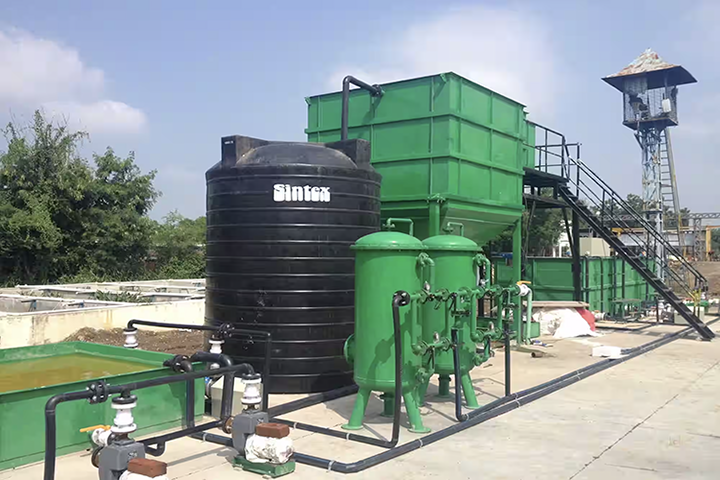STP Plant Manufacturer
Sewage Treatment Plant
A Sewage Treatment Plant (STP) is a vital facility used to treat wastewater from various sources, including residential, commercial, and industrial areas, before it is released into the environment. The treatment process typically involves multiple stages using physical, chemical, and biological methods to remove harmful contaminants such as solids, organic materials, pathogens, and nutrients.
The treatment process generally begins with screening to remove large debris, followed by primary settling to separate solids. Biological oxidation breaks down organic matter, while disinfection eliminates harmful microorganisms. These processes work together to ensure the treated wastewater meets environmental and regulatory standards.
By effectively treating wastewater, STPs prevent the pollution of water bodies, safeguarding ecosystems and public health. Additionally, treated water can often be reused in industrial processes or for non-potable purposes, promoting water conservation. Thus, STPs play a crucial role in protecting the environment and ensuring that wastewater is managed correctly and safely returned to nature.
Why choose Hydroflux Engineering?
Hydroflux Engineering is a trusted provider of STP plant manufacturing and services. Backed by strong technical expertise and innovation, we offer efficient, customized wastewater treatment solutions tailored to meet each client's unique needs.

Our Strengths:
- Innovative Solutions: Utilizing the latest technologies and best practices to deliver efficient, forward-thinking wastewater treatment systems
- Cost-Effective Services: High-quality solutions that optimize performance while staying within budget.
-
Customized Systems:
STP solutions specifically designed to meet your unique industrial needs and goals. - Commitment to Qualit: Adhering to rigorous standards for dependable, durable systems and consistent service.
Working Process of STP Plant.
The Sewage Treatment Plant (STP) operates systematically to clean wastewater before it is reused or safely discharged. The first stage involves preliminary treatment, where large debris such as plastics and rags are removed through screening. This is followed by grit removal to eliminate smaller particles like sand and gravel.
In the primary treatment phase, wastewater is directed into sedimentation tanks where heavier solids settle at the bottom. The more transparent liquid then moves to the biological treatment stage. Here, microorganisms play a key role in breaking down organic pollutants, significantly reducing harmful substances.
Next, the water goes through secondary clarification to separate the biological sludge. The remaining water enters tertiary treatment, which includes advanced filtration and disinfection methods such as UV or chlorination to ensure purity.
Finally, the treated water, which complies with regulatory standards, is discharged or reused. The separated sludge is further processed—through drying or digestion—to minimize environmental impact and is often reused in agricultural applications.
How We Help in STP Plant Requirements
We provide end-to-end solutions for Sewage Treatment Plant (STP) projects, guided by precision, experience, and a deep understanding of each client's unique requirements. Our services are tailored to ensure effective, sustainable, and regulatory-compliant outcomes.
Our process begins with a detailed evaluation of the wastewater characteristics, site conditions, and applicable regulatory standards. We consider all operational requirements to recommend the most suitable treatment technologies that balance performance, cost-efficiency, and environmental impact.
Determining the correct plant capacity is a crucial part of our planning. We assess expected wastewater volumes to ensure the STP system performs optimally under current and future load conditions.
Client collaboration remains at the core of our approach. We work closely with stakeholders to design, plan, and implement systems that align with their goals. We focus on delivering reliable, efficient, and long-lasting wastewater treatment solutions tailored to specific project needs.
Various Types of Sewage Treatment Plant (STP) Technologies
A range of sewage treatment technologies are employed to efficiently treat wastewater, depending on specific project requirements and treatment goals:
- Activated Sludge Process (ASP): Uses microorganisms in aerated tanks to break down organic matter through biological activity.
- Sequential Batch Reactor (SBR): ): A batch-operated system that completes all treatment stages—filling, aeration, settling, and decanting—within a single tank.
- Membrane Bioreactor (MBR): Integrates biological treatment with membrane filtration, producing high-quality, filtered effluent ideal for reuse.
- Moving Bed Biofilm Reactor (MBBR): Features suspended plastic media that support biofilm growth, improving biological treatment performance.
- Extended Aeration Process: Involves prolonged aeration to enhance microbial digestion of waste, suitable for small to medium-scale operations.
- Rotating Biological Contactor (RBC): Uses rotating discs partially submerged in wastewater, where microbes on the disc surface degrade pollutants.
- Trickling Filter: A passive system where wastewater trickles over a fixed bed of media colonized by beneficial microorganisms.
- Oxidation Ditch: : A continuous-loop system using mechanical aerators to mix and aerate wastewater for extended biological treatment.
Each technology offers unique advantages based on treatment efficiency, space availability, and operational needs.
Frequently Asked Questions (FAQ)
Our Clients Testimonials
Our clients consistently commend our high-quality manufacturing and the effectiveness of our wastewater treatment services, encompassing STP, ETP, WTP, Industrial RO, Softener, OWC, and more, delivering exceptional results.
Hydroflux provided an STP system for one of our large residential projects. The plant has been running smoothly, and we’re reusing treated water for landscaping and flushing. Their team did an excellent job with installation and support.

Ravi Sharma
L&T ConstructionAt our telecom office site, Hydroflux installed a compact RO + WTP system. The system is low-maintenance, efficient, and gives us good water quality. They handled the project professionally.

Rajeev Arora
Airtel Facility TeamHydroflux installed a wastewater treatment system for our manufacturing unit. The plant works as per industrial discharge norms. Their timely service and AMC support have been great.

Meenal Kapoor
Samsung ElectronicsWe required an industrial ETP with a ZLD setup. Hydroflux delivered exactly what we needed. Their design is robust and helps us recycle water back into our process lines.

Anil Deswal
Jindal Steel & PowerOur university uses Hydroflux STP to manage sewage within the campus. The treated water is used for gardening, and the plant is eco-friendly. Their technical team is cooperative and trained our staff well.

Dr. Aftab Khan
Jamia Hamdard UniversityWe used Hydroflux for WTP system installation at one of our metro depots. The water treatment system is reliable and easy to maintain. Their service team is always on time.

Sandeep Malhotra
Delhi Metro Rail Corporation (DMRC)We use Hydroflux’s STP and ZLD solution at our bottling plant. Water reuse and discharge quality have both improved. Their ZLD setup helped us clear compliance smoothly.

Vikram Joshi
Pepsi Bottling Unit (Jai Beverages)We installed a RO plant at our Sikandrabad tiles factory. The system provides consistent water quality for tile processing. Very effective and energy-efficient.

Sanjay Singh
Kajaria CeramicsHydroflux installed a compact STP system at our food production plant. Treated water is reused for utility and cleaning. The system is easy to run and completely odorless.

Poonam Verma
Haldiram’s Production UnitOur Gurgaon residential projects have Hydroflux’s STPs. They help us recycle and reuse water, which supports our green building certifications. We’re satisfied with their support even after handover.

Meena Rathi
Raheja DevelopersHydroflux delivered a 690 KLD STP plant for our township. The plant runs automatically and treats large volumes efficiently. It’s been a valuable addition to our sustainability goals.

Ritesh Goyal
Omaxe LtdWe installed an STP from Hydroflux for our resort. Water from bathrooms and kitchen is now treated and reused in our gardens. The plant is silent and blends into our eco-friendly theme.

Arjun Mehta
Best Western ResortHydroflux installed a small but high-efficiency ETP at our Manesar unit. We’ve had no major issues and water discharge is always within limit. Their service is quick and professional.

Priti Sharma
Donaldson India Filter SystemsWe’re using Hydroflux’s STP in our hotel’s backend operations. The system helps us recycle greywater for flushing. Their setup is clean, quiet, and very effective.

Ramesh Yadav
Radisson HotelsHydroflux supplied a robust ETP system for our Bokaro cement plant. It handles high loads and treats effluent effectively. We’ve seen a clear improvement in compliance and water reuse.

Alok Sharma
Dalmia Bharat CementWe installed a compact RO + WTP setup at our Manesar unit through Hydroflux. It runs quietly and requires very little manual handling. The system is reliable and consistent in water output.

Tanya Mehra
BRADY Company India Pvt LtdHydroflux provided an automated ETP solution at our Vapi facility. The system helps us recycle water and control our wastewater discharge. Their service support is excellent even post-installation.

Ritu Jain
HAVELLS IndiaAt our printing unit, Hydroflux installed a RO plant to ensure water quality for ink processing. The plant has reduced scale issues and improved equipment life. It was a great decision to go with them.

Saurabh Chawla
Dainik BhaskarHydroflux provided an MBR-based STP for our Gurgaon campus. The treated water is clear and odorless, perfect for reuse. We are happy with their engineering and service quality.


